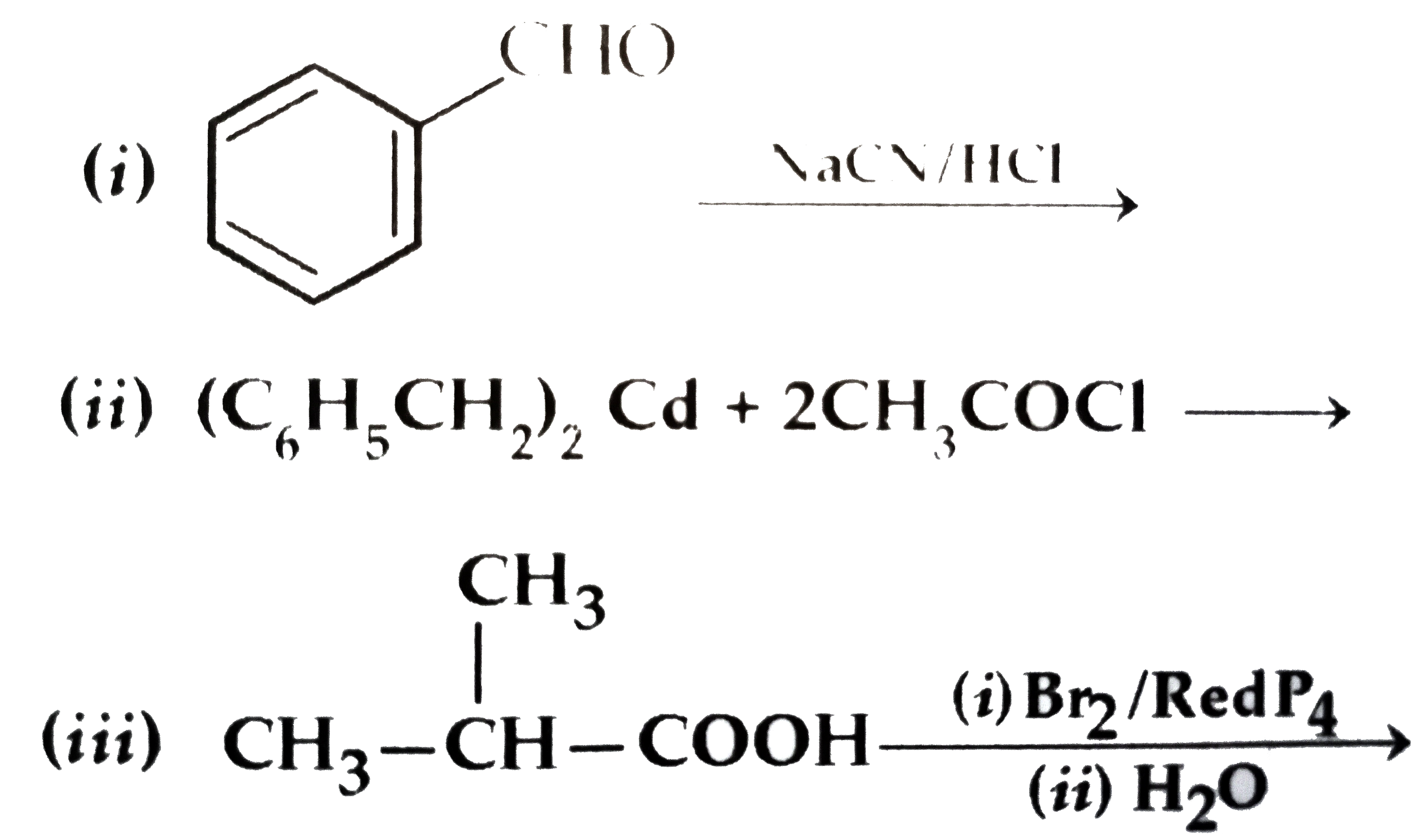Complete the following reaction by identifying X and Y.
CH3CH2C≡CHNaNH2−−−−→XC2H5Br−−−−→Y
X=CH3CH2COONa,Y=CH3CH2CH=CH2
X=CH3CH2C≡CNa,Y=CH3CH2C≡CC2H5
X=CH3CH2CH2CH2Na,Y=CH3CH2CH2CH3
X=CH3CH2CH≡CNa,Y=CH3CH2−C∣C2H5H−CH3
The correct Answer is:B
To solve the question, we need to identify the compounds X and Y in the given reaction sequence. Let's break it down step by step.
Step 1: Identify the starting compound
The starting compound is but-1-yne, which has the structure:
CH3CH2C≡CH
Step 2: Reaction with Sodium Amide (NaNH₂)
When but-1-yne reacts with sodium amide (NaNH₂), it acts as a strong base. The acidic hydrogen on the terminal alkyne (the hydrogen attached to the carbon that is triple-bonded) is removed, leading to the formation of a sodium acetylide. The reaction can be represented as:
CH3CH2C≡CH+NaNH2→CH3CH2C≡C−Na++NH3
Here, the product formed is sodium butynylide, which we can denote as X:
X=CH3CH2C≡CNa
Step 3: Reaction with Ethyl Bromide (C₂H₅Br)
Next, X reacts with ethyl bromide (C₂H₅Br). The sodium acetylide (X) will undergo an SN2 reaction with ethyl bromide. The nucleophilic carbon (C⁻) in the acetylide will attack the carbon in ethyl bromide, resulting in the displacement of the bromine atom:
CH3CH2C≡C−Na++C2H5Br→CH3CH2C≡C−C2H5+NaBr
The product formed after this reaction is:
Y=CH3CH2C≡C−C2H5
This compound can be represented as but-2-yne:
Y=CH3C≡CC2H5
Final Answer
Thus, we have identified:
- X=CH3CH2C≡CNa
- Y=CH3C≡CC2H5
The starting compound is but-1-yne, which has the structure:
CH3CH2C≡CH
When but-1-yne reacts with sodium amide (NaNH₂), it acts as a strong base. The acidic hydrogen on the terminal alkyne (the hydrogen attached to the carbon that is triple-bonded) is removed, leading to the formation of a sodium acetylide. The reaction can be represented as:
CH3CH2C≡CH+NaNH2→CH3CH2C≡C−Na++NH3
X=CH3CH2C≡CNa
Next, X reacts with ethyl bromide (C₂H₅Br). The sodium acetylide (X) will undergo an SN2 reaction with ethyl bromide. The nucleophilic carbon (C⁻) in the acetylide will attack the carbon in ethyl bromide, resulting in the displacement of the bromine atom:
CH3CH2C≡C−Na++C2H5Br→CH3CH2C≡C−C2H5+NaBr
Y=CH3CH2C≡C−C2H5
This compound can be represented as but-2-yne:
Y=CH3C≡CC2H5
Thus, we have identified:
- X=CH3CH2C≡CNa
- Y=CH3C≡CC2H5
Topper's Solved these Questions
- HYDROCARBONS BOOK - NCERT FINGERTPS ENGLISHCHAPTER - HYDROCARBONS EXERCISE - Higher Order Thinkin Skills
7 Videos
- HYDROCARBONS BOOK - NCERT FINGERTPS ENGLISHCHAPTER - HYDROCARBONS EXERCISE - Assertion & Reason
15 Videos
- EQUILIBRIUM BOOK - NCERT FINGERTPS ENGLISHCHAPTER - EQUILIBRIUM EXERCISE - Assertion And Reason
15 Videos
- HYDROGEN BOOK - NCERT FINGERTPS ENGLISHCHAPTER - HYDROGEN EXERCISE - Assertion And Reason
15 Videos
Similar Questions
CH≡CHNaNH2−−−−→[A]CH3Br−−−→[B]
View SolutionComplete the following reactions
CH3CH=CH2mCPBA−−−−→AC2H5MgBr−−−−−−→H3O+B
View SolutionComplete the following reactions: a. H−C(A)≡C−H1mol−−−−→NaNH2(B)CH3Br−−−→(C)

g. H−C≡C(A)−H1mol−−−−→NaNH2(B)Br(CH2)8Br−−−−−−−−→(C)

View SolutionComplete the following reaction CH3−C∣CH3=CH−CH3H2,Ni−−−→?
View SolutionComplete the following reactions:
(i)
(ii) (C6H5CH2)2Cd+2CH3COC<o
(iii) CH3−CH3∣CH−COOH(i)Br2/RedP4−−−−−−−−−→(ii)H2O
View SolutionComplete the following reaction sequence :
CH3−O∣∣C−CH3(i)CH3MgBr−−−−−−−−→(ii)H2O(A)Na metal−−−−→ether(B)CH3−Br−−−−−→(C)
View SolutionComplete the following reaction sequence :
CH3−O∣∣C−CH3(i)CH3MgBr−−−−−−−−→(ii)H2O(A)Na metal−−−−→ether(B)CH3−Br−−−−−→(C)
View SolutionThe major product of the following reaction is :
C6H5CH2−CH3∣C∣Br=CH2−CH3C2H5ONa−−−−−→C2H5OH
View SolutionThe major product of the following reaction is :
C6H5CH2−CH3∣C∣Br−CH2−CH3C2H5ONa−−−−−→C2H5OH
View SolutionIdentify and explain the formation of the products in the following reaction :
CH3 |CH3−C−CH2Br C2H5OH−−−−−−−→heat | CH3
View Solution
